Castel Del Monte and Trani, Puglia, 27th June
If there had been a tutelary spirit of our journey through Sicily and Puglia it must have been the great Holy Roman Emperor and King of Sicily, Frederick II, who lived from 1195 to 1250. Reigning from the age of 3, his achievements were as diverse as keeping a menagerie of exotic animals, winning a Crusade to become King of Jerusalem and writing the most authoritative book on hawking in the Middle Ages. He was brought up in cosmopolitan Palermo and his thoughts were influenced as much by Muslims as Christians. He certainly developed his love of science from his Arab teachers and all his life he was a patron of art and learning. They defined the splendour of his court.
(Please click on thumbnails below to scroll through the galleries in this post:)
-
The young Frederick II hunting in his Royal Menagerie in Palermo
(painting by Bruno Caruso on exhibition in the Palatino Capello, Palermo)
-
Trani Cathedral
(photo by Hong Ying)
- Castle courtyard
- Castel del Monte
Altogether he built more than 200 castles in Italy and Sicily, so many that every time we saw a castle we joked in the car: “Who built that one then?” Answer in chorus: “Frederick II”. (In Egypt of course one can do the same with statues of Pharaohs. They all seem to be of Rameses II). Throughout our journey we felt Frederick’s presence, no more so than today, when we drove inland and then up a perfect conical mountain and found on the top a castle, which was an exact octagon. Besides its eerie architectural precision there was something very strange about it. The building seemed to be the embodiment of a mystical or mathematical code. Not only the outer keep but each of the rooms inside, as well as the central courtyard, were octagons. Yet it was not all symmetrical. Perplexingly some of the floor levels were misaligned. The numbers of windows were not in sequence. In something so deliberately architectured one felt these flaws must have had a meaning. Of course an octagon is a symbol of the perfection of God, hence eight sided baptisteries which are common throughout mediaeval Europe, but there seemed to be something more arcane here. We were in the realm of Umberto Eco, whose model for his monastery in ‘The Name of the Rose” may have been modelled on Castel del Monte.
Frederick was also a great church builder. One of the most beautiful of his churches we came across was in Trani, an ancient port within view of Castel del Monte. We rejoiced in the spareness of its Romanesque architecture – a great contrast to the fussy Baroque that had somewhat repelled us on our way through Lecce the day before. Like the castle on the hill, there was something perfect and pure about this church that stood alone on the waterfront facing the vastness of the sea.
Laurence Browne, our companion on our travels since Bari, got into conversation with the very knowledgeable lady in the tourist information office, a former English speaking guide. She told him that the Trani Cathedral had also been covered in Baroque decoration but it had been stripped back to its original form by order of the Cultural Ministry in the 1950s. Laurence remarked that this was a very enlightened thing to have done. “You say that because you’re English,” she replied., “English have a love of empty churches. That doesn’t mean that every Italian feels the same.”
“Oh surely…” said Laurence.
“Surely nothing,” she said. “Here you are, admiring Frederick II. Tell me, what did you know of Frederick II before you came here?”
“Not much,” he admitted shamefacedly. “He’s not really taught in English schools.”
“So there you are. What can you tell me about what was his original architecture? In Italy it is different. We see Frederick II as a father of our country.” She put her hands on her hips. “All right, where are you going now?”
“The Gargano,” muttered Laurence. “To visit Padre Pio…”
“Padre Pio? Ha, that’s very Italian of you.” She gave him a sardonic glance. “But you’ll take time to go to the Foresta Umbra too, yes? To have a picnic perhaps?”
“As it happens, we were thinking of visiting the national park…Yes, why not?… maybe, we will.”
“Of course you will. It’s woods. You are English. You like woods and nature.” She shrugged dismissively and went back to sorting her brochures.
We left, bruised.
Monte San Angelo and San Giovanni Rotondo, the Gargano Peninsula, Puglia
As we approached the spur of Italy’s boot – the jutting spit that breaks the straight line of Eastern Italy’s long coast, geologically a bit of Dalmatia that got attached in some pre-Pleiostine age and therefore, some say, not really part of Italy – I put my foot on the brake to slow down for a roundabout. An empty plastic Coca-Cola bottle suddenly slipped between my feet and the brakes and I suddenly found I was accelerating. The car flew out of control and it took a few alarming seconds to right the situation. Shortly afterwards, when we were well into the Gargano peninsula we found ourselves climbing precipitous mountain roads in the waning light and soon were lost in a dark forest. The hotel in Vieste, when we eventually arrived there, was not what we had expected…
So began a chain of small accidents and misfortunes that dogged us all the time we were in the Gargano area, Nothing in itself was that serious – a sense of claustrophobia in a church, mislaid equipment, lost or broken telephones – but it added to a sense of weirdness, and we all felt lighter hearted when we left two days later.
It was not as if we were not suspecting something like this. Perhaps we had been hoping for it. Laurence and I had attended a Synchronicity Conference near Siena the year before and it was after that we had promised ourselves a trip to the tomb of Padre Pio. We had no idea what to expect. Perhaps we were looking for a Numen, the spiritual energy that one sometimes senses in places of ancient worship, or in those associated with shamen.
Certainly, everything we knew of Padre Pio’s life had been strange, with indications that he might indeed have been possessed or was possessed by a spiritual force. Italy’s St Francis of the 20th century, he was a mild-mannered, greybearded monk who suffered the Stigmata throughout his life. He was also reputed to be able to bilocate – curing the sick in one town when he was known to be in another. There are apparently well attested reports that US bomber pilots during WW2 were on every mission prevented from dropping their loads on Padre Pio’s home town of San Giovanni Rotondo by a ‘flying monk’ floating in front of their cockpits and stretching out his wounded palms. And of course there is the love that approached adulation he inspired in tens of thousands of Christian worshippers throughout the world. He died in 1968, is now sainted and perhaps the best loved figure in the Roman Catholic Church. San Giovanni Rotondo is a place of pilgrimage. Padre Pio’s image can be found in shops, restaurants and homes in my village of Force in Le Marche and all over the rest of the country. Like St Catherine of Siena his body has not corrupted.
Curiously, it was the latter fact that most interested Laurence because he had read that the Gargano is located on one of the world’s most famous ley lines, the so-called Apollo Line, that stretches from the Skelligs off Southern Ireland, through Mont San Michel in Britanny, through Siena, Gargano, Delphi, ultimately to Megiddo (or Armageddon) in Israel. There are several saints along this route whose bodies have been found to be incorruptible. Also there is the coincidental association with St Michael (Monte San Angelo and Mont St Michel). Certainly, before Padre Pio came along, the spiritual event most associated with the Gargano region was the appearance of the angel St Michael to a Bishop Laurence in a grotto on top of a mountain in the 5th Century AD. The Grotto is still there, deep under a Romanesque church in the centre of the town of Monte San Angelo that grew up around it (complete with castle built by Frederick II). A long tunnel takes one down to the shrine. In the cave where the angel manifested, men and women pray passionately and silently kneeling against the altar rails behind which a rather fearsome white statue of St Michael with burning sword hangs over them. The silence is heavy, almost oppressive, unlike in any other Roman Catholic shrine. If there is a Numen there, it is a very forceful one.
- Saint stakes (photo by Hong Ying)
- Padre Pio and Saint Michael knick-knacks, Monte San Angelo
- A priest communes with angels in the Monte S Angelo Grotto (photo by Hong Ying)
In contrast, the great church and hospital complex that has been built over the coffin of St Pio in nearby San Giovanni Rotondo is benign and peaceful. It is also a museum to clearly a humble and most loveable man – there are many photos and recreations of the simple rooms in which he lived his life of pain and discomfort (there is some stress on the bandages that he had to change every few hours to cover the wounds of his Stigmata).
One wonders why the Vatican, for most of his life, tried to repress the news of his miracles. Was perhaps the real thing – a holy man with a direct relationship to God – too unpredictable and uncontrollable, thus dangerous, for the established Church? Laurence and I did notice the rather ostentatious presence of photographs of that other recently made saint, Pope John Paul II all over the Padre Pio shrine, with heavy endorsements of course, as well as from the present Pope. If this had been the People’s Republic of China – Heaven forfend the parallel – I might have thought this smacked of the Communist authorities bringing the myth of a maverick and popular Revolutionary into line with Party orthodoxy, back into the safety of the fold, as it were. But I am neither Catholic nor Communist so cannot tell.
We left Gargano loaded with enormous loaves of bread, local cheeses and wines. We had eaten in good restaurants, found a charming hotel, and enjoyed ourselves as tourists here as much as anywhere else in Puglia.
But even though we could not quite put our finger on any notable spiritual power source or mysterious synchronicity, in fact anything that didn’t smack of ordinary Italy, it is a fact that we did find the Foresta Umbra dark and sinister – we did NOT wish to loiter over a picnic there – and there was this other disturbing occurrence that we were having accidents and breaking things, which did all add up to an indefinable impression that this Gargano was a very strange place indeed. Perhaps it was the raw faith we had witnessed in the silent worshippers round Saint Michael, and in the industry of pilgrimage that has grown up around Padre Pio. It is strong meat for comfortable agnostics. (I can hear the voice of the information lady in Trani: “You English!”)
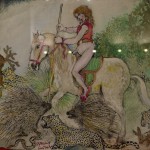
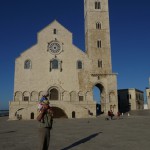
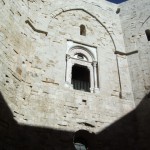
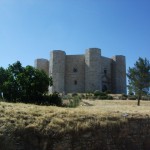
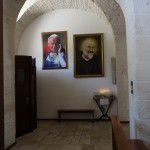
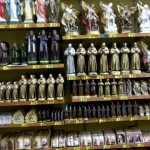
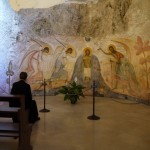


Great to have read your blogs! We were in Puglia in Sept. 2010 and 2011 and in Sicily this last June. Off to Calabria next end of March. All with art historians and NADFAS, so v. interesting to read your impressions too. Off to Canada in 3 weeks to see the family and back in time to greet 2 more great grand-children due in September! Love Tita